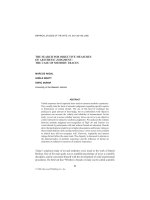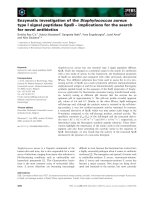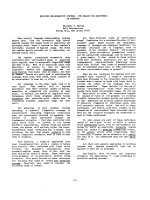pharmacogenomics the search for individualized therapies
Bạn đang xem bản rút gọn của tài liệu. Xem và tải ngay bản đầy đủ của tài liệu tại đây (6.96 MB, 585 trang )
Julio Licinio, Ma-Li Wong (Editors)
Pharmacogenomics
The Search for Individualized Therapies
Pharmacogenomics: The Search for Individualized Therapies.
Edited by J. Licinio and M L. Wong
Copyright © 2002 Wiley-VCH Verlag GmbH & Co. KGaA
ISBNs: 3-527-30380-4 (Paper); 3-527-60075-2 (Electronic)
Pharmacogenomics
The Search for Individualized Therapies
Edited by
Julio Licinio and Ma-Li Wong
Pharmacogenomics: The Search for Individualized Therapies.
Edited by J. Licinio and M L. Wong
Copyright © 2002 Wiley-VCH Verlag GmbH & Co. KGaA
ISBNs: 3-527-30380-4 (Paper); 3-527-60075-2 (Electronic)
Editors
Julio Licinio
Ma-Li Wong
Interdepartmental Clinical Pharmacology Center
UCLA Neuropsychiatric Institute
and School of Medicine
Gonda Center 3357A
695 Charles Young Drive So.
Los Angeles, CA 90095-1761
USA
e-mails:
Library of Congress Card No.: applied for
British Library Cataloguing-in-Publication Data
A catalogue record for this book is available from
the British Library.
Die Deutsche Bibliothek – CIP-Cataloguing-in-
Publication Data
A catalogue record for this publication is available
from Die Deutsche Bibliothek
© WILEY-VCH Verlag GmbH
Weinheim (Germany), 2002
All rights reserved (including those of translation
in other languages). No part of this book may be
reproduced in any form – by photoprinting, mi-
crofilm, or any other means – nor transmitted or
translated into machine language without written
permission from the publishers. Registered
names, trademarks, etc. used in this book, even
when not specifically marked as such, are not to
be considered unprotected by law.
printed in the Federal Republic of Germany
printed on acid-free paper
Composition K+V Fotosatz GmbH, Beerfelden
Printing Strauss Offsetdruck GmbH,
Mörlenbach
Bookbinding J. Schäffer GmbH & Co. KG,
Grünstadt
ISBN 3-527-30380-4
n This book was carefully produced. Nevertheless,
editors, authors and publisher do not warrant the
information contained therein to be free of er-
rors. Readers are advised to keep in mind that
statements, data, illustrations, procedural details
or other items may inadvertently be inaccurate.
Pharmacogenomics: The Search for Individualized Therapies.
Edited by J. Licinio and M L. Wong
Copyright © 2002 Wiley-VCH Verlag GmbH & Co. KGaA
ISBNs: 3-527-30380-4 (Paper); 3-527-60075-2 (Electronic)
We dedicate this book to our parents
Áurea and João, and Yin Shen and Kwok Keung.
VPharmacogenomics: The Search for Individualized Therapies.
Edited by J. Licinio and M L. Wong
Copyright © 2002 Wiley-VCH Verlag GmbH & Co. KGaA
ISBNs: 3-527-30380-4 (Paper); 3-527-60075-2 (Electronic)
We acknowledge the exceptional role of Barbara A. Levey, M.D., in bringing us
into the field of clinical pharmacology, of which pharmacogenomics is a new fron-
tier. We are very fortunate to have worked with Karin Dembowsky at WILEY-VCH
whose enthusiasm, expertise, and dedication greatly contributed to this project.
Professor Boris Vargaftig’s generous invitation for one of us (J. L.) to join the Sci-
entific Committee of the Euroconference “Pharmacogenetics and Pharmacogen-
omics” (Institut Pasteur, Paris, France, October 12–13, 2000) greatly contributed to
enhance our understanding of the state-of-the-art in pharmacogenomics.
Acknowledgements
Pharmacogenomics: The Search for Individualized Therapies.
Edited by J. Licinio and M L. Wong
Copyright © 2002 Wiley-VCH Verlag GmbH & Co. KGaA
ISBNs: 3-527-30380-4 (Paper); 3-527-60075-2 (Electronic)
In this book leading experts provide the state-of-the-art in the emerging and excit-
ing field of pharmacogenomics. The multitude of ways that pharmacogenomics
can be approached and applied reflects the possibilities brought about by the
wealth of data generated by the Human Genome Project, in conjunction with par-
allel advances in bioinformatics and biotechnology. Procedures that are now rou-
tine were a decade ago thought to be impossible. We now study the simultaneous
expression of thousands of genes and test thousands of discrete gene variations
(single nucleotide polymorphisms) in one sample.
To clinicians and researchers pharmacogenomics is powerfully attractive. Individ-
ualized treatment is the Holy Grail of medical practice. However, unlike medieval
knights who would leave family and country behind in their adventurous quest,
we must stay firmly grounded in the reality of clinical practice and ethics as we
search the rich minefields of genomic data for the sequences that will bring about
a new era in individualized therapeutics. The quest for the Grail of pharmacogen-
omics is irresistible and enthralling. The promise of novel, individualized, more
efficacious treatments with minimal or no adverse reactions is almost within
reach. Given the fact that key diseases are complex and of unknown cause, the ex-
pectation of better treatments is extremely appealing. However, is such hope real
or a mirage? Will the popular saying “too good to be true” apply to this new area
of biomedical research?
Each chapter in this book contributes a piece of the puzzle that will reveal not
only the possibilities, but also the complexities of the field. The final picture is
still evolving, but our perception as we complete the editing of this volume is that
we are witnessing the beginning of an eruption that will unleash revolutionary
changes in patient-oriented research and in data processing and integration. It is
hoped that this will directly impact on disease treatments, but to achieve such a
goal there will be a need to overcome multiple challenges. We will need to devel-
op analytical tools to deal with high volumes of data, data mining, and data inte-
gration. New strategies are required to bridge genomics and proteomics and new
tools are needed to understand complex information, including behavioral data.
Moreover, as the progress of pharmacogenomics is brought to the clinic, it be-
comes necessary to address increasingly complex ethical issues in patient-oriented
research and in treatment design and delivery.
VII
Preface
Pharmacogenomics: The Search for Individualized Therapies.
Edited by J. Licinio and M L. Wong
Copyright © 2002 Wiley-VCH Verlag GmbH & Co. KGaA
ISBNs: 3-527-30380-4 (Paper); 3-527-60075-2 (Electronic)
Pharmacogenomics represents a paradigm shift in medicine. In the 21st cen-
tury the search to understand overwhelming complexity replaces the reductionis-
tic approach to science that was a hallmark of the 20th century. Until recently sci-
entific thinking led investigators to approach a topic by controlling conditions and
studying one or few aspects of the problem. In this new century we fully acknowl-
edge the complexity of biology, and the challenge is now one of feasibility. We
need to discover what will the smallest unit of pharmacogenomic data be that will
support final conclusions.
This book provides chapters on the latest updates on genomic science, related
methodological issues, and the application of genomics to biological systems and
to therapeutics of diseases that are public health problems worldwide. These are
followed by chapters on ethical considerations. We conclude with a chapter on the
role of vascular proteomics in individualized treatment. Many of the chapters start
with a discussion of what pharmacogenomics is and its distinction from pharma-
cogenetics. Rather than edit out those – at times conflicting and redundant – para-
graphs we thought it would be in the reader’s best interest to leave those in, so
that different individual perspectives could be presented. As this is such a new
and emerging field, concepts and definitions are still evolving. While we person-
ally believe that the term “pharmacogenomics” will eventually replace “pharmaco-
genetics,” or be used interchangeably, others have a more strict view of the dis-
tinction between these concepts. We opted to have each author introduce the field
in her/his chapter for readers to appreciate the diversity of views and the evolu-
tion of the field.
Our goal when we first conceptualized this project was to bring together in one
volume the current level of development in pharmacogenomics. We are delighted
that leading experts have participated in this endeavor and we are very grateful to
them for having made that goal a reality.
Los Angeles, January 2002 Julio Licinio and Ma-Li Wong
PrefaceVIII
Preface VII
List of Contributors XXIII
Color Plates XXXI
1 Introduction to Pharmacogenomics:
Promises, Opportunities, and Limitations
1
Urs A. Meyer
Abstract
1
1.1 Pharmacogenetics – The Roots of Pharmacogenomis 1
1.2 Pharmacogenomics – It is Not just Pharmacogenetics 3
1.2.1 Genetic Drug Response Profiles 3
1.2.2 The Effect of Drugs on Gene Expression 4
1.2.3 Pharmacogenomics in Drug Discovery and Drug Development 5
1.3 Pharmacogenomics – Hopfe or Hype? 5
1.4 References 7
2 The Human Genome 9
Samuel Broder, G. Subramanian and J. Craig Venter
Abstract
9
2.1 Introduction 9
2.2 Expressed Sequence Tags (ESTs) and Computational Biology:
The Foundation of Modern Genomic Science
10
2.3 Microbial Genomics 12
2.3.1 Computational Analysis of Whole Genomes 13
2.3.2 Comparative Genome Analysis 13
2.4 Genomic Differences that Affect the Outcome of
Host-Pathogen Interactions: A Template for the Future
of Whole-Genome-Based Pharmacologic Science
18
2.5 More Lessons from the Human Genome 22
2.5.1 Protein-Coding Genes 22
2.5.2 Repeat Elements 23
IX
Contents
Pharmacogenomics: The Search for Individualized Therapies.
Edited by J. Licinio and M L. Wong
Copyright © 2002 Wiley-VCH Verlag GmbH & Co. KGaA
ISBNs: 3-527-30380-4 (Paper); 3-527-60075-2 (Electronic)
2.5.3 Genome Duplication 24
2.5.4 Analysis of the Proteome 25
2.5.5 DNA Variation 26
2.6 Biological Complexity and the Role of Medicine in the Future
of the Genome
28
2.7 Conclusion 29
2.8 References 29
3 Turning SNPs into Useful Markers of Drug Response 35
Jeanette J. McCarthy
Abstract
35
3.1 Introduction 35
3.2 Two Approaches for Employing SNPs in Pharmacogenomics 36
3.2.1 Candidate Gene Studies 36
3.2.2 Whole Genome Linkage Disequilibrium Mapping Studies 38
3.2.3 Comparison of Candidate Gene and Whole Genome LD Mapping 40
3.3 How Many SNPs are Needed and What Kind are Useful
for Pharmacogenomic Studies
41
3.3.1 Location 42
3.3.2 Frequency 43
3.3.3 Haplotype Analysis 44
3.3.4 Number of SNPs Required for Whole Genome
LD Mapping Studies
46
3.4 Study Designs for Pharmacogenomic Analysis 46
3.4.1 Challenges Unique to Pharmacogenomics 46
3.4.2 Clinical Trials, Case-Control and Cohort Studies 47
3.5 Analytical Issues is Pharmacogenomic Studies 48
3.5.1 Effect of LD on Sample Size 48
3.5.2 Multiple Hypothesis Testing 49
3.5.3 Gene–Drug Interaction 50
3.6 Development of Pharmacogenomic Markers 51
3.7 Conclusion 52
3.8 References 53
4 Association Studies in Pharmacogenomics 57
Laurent Essioux, Benoit Destenaves, Philippe Jais and François Thomas
Abstract
57
4.1 Introduction 57
4.2 Variability and ADR in Drug Response:
Contribution of Genetic Factors
58
4.3 Multiple Inherited Genetic Factors Influence the Outcome
of Drug Treatments
60
4.3.1 Background 60
4.3.2 Liver Metabolism Enzymes 60
4.3.3 Transporters 62
ContentsX
4.3.4 Plasma Binding Proteins 62
4.3.5 Drug Targets 62
4.4 Association Studies in Pharmacogenomics 64
4.4.1 The Principles of Association Studies 64
4.4.2 Study Design 64
4.4.3 Direct Approach: A Hypothesis-Driven Strategy 66
4.4.4 Indirect Approach: A Hypothesis-Generating Strategy 67
4.5 SNP Assembly into Maps 68
4.6 Strategies for Pharmacogenomic Association Studies 69
4.6.1 Candidate Genes 69
4.6.2 Genome-Wide Scan 71
4.7 Expected Benefits of Pharmacogenomics in Drug R & D 72
4.7.1 Background 72
4.7.2 Identification of New Targets 72
4.7.3 Pre-Clinical Development Phase 74
4.7.4 Pre-Marketing Clinical Trials 74
4.7.5 Post-Marketing Phase IV 75
4.7.6 Targeting Drugs to the Individual 76
4.8 Conclusion 76
4.9 References 77
5 Genomics Applications that Facilitate the Understanding
of Drug Action and Toxicity
83
L. Mike Furness
Abstract
83
5.1 Platform Technologies 83
5.1.1 Genomics 83
5.1.2 Proteomics 85
5.1.3 Bioinformatics 86
5.2 The Pharmaceutical Process 89
5.3 Application to the Pharmaceutical Industry 91
5.3.1 Understanding Biology and Disease 92
5.3.2 Target Identification and Validation 101
5.3.3 Drug Candidate Identification and Optimization 103
5.3.4 Safety and Toxicology Studies 106
5.4 Application to the Medical Research Community 108
5.5 Conclusions 109
5.6 References 110
6 The Role of Pharmacogenetics in Drug Discovery and Therapeutics 127
Klaus Lindpaintner
6.1 Introduction 127
6.2 Definition of Terms 127
6.2.1 Pharmacogenomics 127
6.2.2 Pharmacogenetics 128
Contents XI
6.3 Pharmacogenomics: Finding New Medicines Quicker
and More Efficiently
129
6.4 Pharmacogenetics: More Targeted, More Effective Medicines
for our Patients
130
6.4.1 Genes and Environment 130
6.4.2 An Attempt at a Systematic Classification 130
6.4.2.1 Pharmacogenetics as a Consequence of “Subclinical”
Differential Diagnosis
132
6.4.2.2 Pharmacogenetic Effects of Palliative Drugs due
to Structural Target Diversity
135
6.4.2.3 Different Classes of Markers 137
6.4.2.4 Complexity is to be Expected 137
6.5 Pharmacogenetic Testing for Drug Efficacy vs. Safety 137
6.6 Ethical – Societal Aspects of Pharmacogenetics 139
6.7 Summary 141
6.8 References 141
7 Pharmacogenomics and Drug Design 143
Philip Dean, Paul Gane and Edward Zanders
Abstract
143
7.1 Introduction 143
7.2 The Need for Protein Structure Information 144
7.3 Protein Structure and Variation in Drug Targets –
the Scale of the Problem
145
7.4 Mutations in Drug Targets Leading to Changes in the
Ligand Binding Pocket
146
7.4.1 b
2
-Adrenergic Receptor 146
7.4.2 STI-571 and BCR-ABL 147
7.5 Resistance to Human Immunodeficiency Virus (HIV) 148
7.6 In silico Design of Small Molecules 148
7.7 Automated Drug Design Methods 149
7.8 Structure-Based Drug Design 150
7.9 Ligand-Based Drug Design 154
7.10 Future Directions 155
7.11 Conclusions 156
7.12 References 156
8 The Pharmacogenomics of Human P-Glycoprotein 159
Martin F. Fromm and Michel Eichelbaum
Abstract
159
8.1 Introduction: Importance of Active Transport Mechanisms
for Uptake, Tissue Distribution and Elimination of Xenobiotics
159
8.2 Structure of the Human MDR1 Gene 160
8.3 P-glycoprotein Expression in Healthy Tissues 161
8.4 Function of P-Glycoprotein 161
ContentsXII
8.4.1 Intestinal P-Glycoprotein 164
8.4.2 P-Glycoprotein and the Blood–Brain Barrier 164
8.4.3 P-Glycoprotein in Other Tissues 165
8.5 Identification of MDR1 Mutations and Their Consequences
for Function
165
8.6 Racial Differences in Frequency of MDR1 Mutations 170
8.7 MDR1 Mutations and the Potential Risk for Idiopathic
or Spontaneous Diseases
171
8.7.1 P-Glycoprotein and Ulcerative Colitis 171
8.7.2 P-Glycoprotein and HIV Infection 172
8.7.3 P-Glycoprotein and Renal Cell Carcinoma 173
8.8 Aspects of P-Glycoprotein Regulation 173
8.9 Conclusions 174
8.10 References 175
9 Pharmacogenomics of Drug Transporters 179
Rommel G. Tirona and Richard B. Kim
Abstract
179
9.1 Introduction 179
9.2 Organic Anion Transporting Polypeptide Family (OATP) 180
9.2.1 OATP-A 180
9.2.2 OATP-B 183
9.2.3 OATP-C 187
9.2.4 OATP-E 189
9.2.5 OATP8 189
9.2.6 Other OATPs 190
9.3 Organic Anion Transporter Family (OAT) 190
9.3.1 OAT1 190
9.3.2 OAT2 190
9.3.3 OAT3 191
9.3.4 OAT4 191
9.4 Organic Cation Transporter Family (OCT) 191
9.4.1 OCT1 191
9.4.2 OCT2 192
9.4.3 OCT3 192
9.5 Novel Organic Cation Transporter Family (OCTN) 193
9.5.1 OCTN1 193
9.5.2 OCTN2 193
9.6 Peptide Transporter Family (PepT) 194
9.6.1 PepT1 194
9.6.2 PepT2 194
9.7 Multidrug Resistance-Associated Proteins (MRP) 194
9.7.1 MRP1 194
9.7.2 MRP2 195
9.7.3 MRP3 196
Contents XIII
9.7.4 MRP4 196
9.7.5 MRP5 197
9.7.6 MRP6 197
9.8 Multidrug Resistance (P-Glycoprotein) Family (MDR) 198
9.8.1 MDR1 198
9.8.2 MDR3 198
9.8.3 SPGP (BSEP) 199
9.9 “White” ABC Transporter Family 199
9.9.1 BCRP 199
9.10 Conclusions 200
9.11 References 201
10 Pharmacogenomics of Asthma Treatment 215
Lyle J. Palmer, Eric S. Silverman, Jeffrey M. Drazen and Scott T. Weiss
Abstract
215
10.1 Introduction 215
10.2 Pharmacogenomic Pathways and Phenotypes 216
10.3 Genetic Association Analysis Using Single Nucleotide
Polymorphisms (SNPs)
218
10.4 Previous Studies of Asthma Pharmacogenomics 220
10.4.1 Pharmacogenomics of b-Agonists in Asthma 220
10.4.2 Pharmacogenomics of Leukotrienes in Asthma 223
10.5 Statistical Issues 225
10.5.1 Genetic Heterogeneity and Population Stratification 225
10.5.2 Statistical Power 226
10.6 Future Directions and Issues 227
10.7 Conclusions 229
10.8 References 229
11 Endothelial Cells are Targets for Hydroxy Urea: Relevance to the
Current Therapeutic Strategy in Sickle Cell Disease
235
Claudine Lapouméroulie, Manuel Brun, Marie Hélène Odièvre
and Rajagopal Krishnamoorthy
11.1 Hydroxy Urea 235
11.2 Sickle Cell Anemia 236
11.3 Hydroxy Urea Therapy in Sickle Cell Anemia 238
11.4 Issues 239
11.5 Experimental Study Design 240
11.6 Major Effect of HU 241
11.7 ICAM-1 245
11.8 ET-1 247
11.9 Conclusion 247
11.10 References 248
ContentsXIV
12 Pharmacogenomics and Complex Cardiovascular Diseases –
Clinical Studies in Candidate Genes
251
Bernhard R. Winkelmann, Markus Nauck, Michael M. Hoffmann,
and Winfried März
Abstract
251
12.1 Introduction 251
12.2 Complexity of Clinical Phenotypes 253
12.3 Limitations 253
12.4 Studies of the Impact of Nucleotide Sequence Variation
on Drug Effects
254
12.4.1 Angiotensin I-Converting Enzyme Gene 254
12.4.2 Angiotensinogen Gene 257
12.4.3 Drug Metabolizing Enzymes and Drug Transporters 259
12.4.4 Genetic Polymorphisms of the b-Adrenoreceptors 259
12.5 Conclusions 261
12.6 References 261
13 Pharmacogenomics of Lipid-Lowering Agents 267
Michael M. Hoffmann, Bernhard R. Winkelmann, Heinrich Wieland,
and Winfried März
Abstract
267
13.1 Introduction 267
13.2 The Metabolism of Plasma Lipoproteins 268
13.3 Pharmacogenomics of Lipid-Lowering Agents 269
13.3.1 Bile Acid Sequestrants (Resins) 269
13.3.2 Fibrates 269
13.3.3 Niacin (Nicotinic Acid) 270
13.3.4 Probucol 271
13.3.5 HMG-CoA Reductase Inhibitors (Statins) 271
13.4 Conclusion 276
13.5 References 276
14 Pharmacogenomics of Chemotherapeutic Agents in Cancer Treatment 283
Federico Innocenti, Lalitha Iyer and Mark J. Ratain
Abstract
283
14.1 Pharmacological Treatment of Cancer and Importance
of Pharmacogenomics
283
14.2 Pharmacogenetic Determinants of Toxicity after
Cancer Chemotherapy
285
14.2.1 6-Mercaptopurine and TPMT Pharmacogenetics 285
14.2.1.1 Clinical Use and Toxicity of 6-MP in Childhood
Acute Lymphoblastic Leukemia
285
14.2.1.2 Metabolism of 6-MP – Activating and Inactivating Pathways
and Their Clinical Relevance
285
Contents XV
14.2.1.3 Reduced Tolerance to 6-MP in Patients with Genetic Impairment
of TPMT Activity
286
14.2.1.4 Prediction of TPMT Deficiency 287
14.2.1.5 6-MP Dose Adjustment in ALL Patients 288
14.2.2 5-Fluorouracil and DPD Pharmacogenetics 289
14.2.2.1 Clinical Use and Toxicity of 5-Fluorouracil 289
14.2.2.2 Metabolism of 5-FU – Activating and Inactivating Pathways
and Their Clinical Relevance
289
14.2.2.3 Life-Threatening Toxicity in DPD-Deficient Patients 290
14.2.2.4 DPD Genotype and Molecular Basis of DPD Deficiency 291
14.2.2.5 Measures to Predict DPD Deficiency in Patients Receiving 5-FU 291
14.2.3 Irinotecan and UGT1A1 Pharmacogenetics 292
14.2.3.1 Clinical Use and Toxicity of Irinotecan 292
14.2.3.2 Metabolism of Irinotecan – Activating and Inactivating Pathways
and Their Clinical Relevance
292
14.2.3.3 Increased Risk of Toxicity in Cancer Patients
with Gilbert’s Syndrome
294
14.2.3.4 Gilbert’s Syndrome Genotype 294
14.2.3.5 Gilbert’s Syndrome Phenotype and SN-38 Glucuronidation 294
14.2.3.6 Possible Measures to Predict Patients at High Risk of Toxicity
after Irinotecan
295
14.2.4 Amonafide and NAT2 Pharmacogenetics 296
14.2.4.1 Metabolism of Amonafide and NAT2 Polymorphism 296
14.2.4.2 Dose Individualization of Amonafide Based
on N-Acetylator Phenotype
296
14.2.5 MTHFR Gene Polymorphism in Breast Cancer Patients
Receiving CMF Regimen
297
14.2.5.1 MTHFR Function and Polymorphism 298
14.2.5.2 MTHFR Polymorphism as a Determinant of CMF Toxicity 299
14.3 Pharmacogenetic Determinants of Response
after Cancer Chemotherapy
299
14.3.1 Glutathione-S-Transferase Mutations in Cancer Chemotherapy 299
14.3.1.1 GST Pharmacogenetics and Outcome in Solid Tumor Patients 300
14.3.1.2 GST Pharmacogenetics and Outcome in Childhood Leukemias 300
14.3.2 Thymidylate Synthase Gene Promoter Polymorphism
and Response to 5-Fluorouracil-Based Chemotherapy
301
14.3.2.1 Regulation of TS Gene Expression 301
14.3.2.2 Genotyping of the TS Promoter Variable Tandem Repeat
and Clinical Outcome
302
14.4 Conclusion 302
14.5 References 303
ContentsXVI
15 Pharmacogenomics of the Blood–Brain Barrier 311
Jean-Michel Scherrmann
Abstract
311
15.1 Basic Concepts Underlying the Pharmacogenomics
of the Blood–Brain Barrier
312
15.1.1 The Two Barriers 312
15.1.2 Constituents of the Blood–Brain Barrier 313
15.1.2.1 Endothelial Cells in the Blood–Brain Barrier 313
15.1.2.2 Pericytes in the Blood–Brain Barrier 315
15.1.2.3 Astrocytes in the Blood–Brain Barrier 317
15.1.2.4 Basement Membrane at the Blood–Brain Barrier 317
15.2 The Main Gene and Protein Targets for Pharmacogenomics
of the Blood–Brain Barrier
319
15.2.1 Drug-Metabolizing Enzymes at the Blood–Brain Barrier 319
15.2.2 Drug-Carrier Transporters at the Blood–Brain Barrier 321
15.2.2.1 Mono- or Bidirectional Transporters for Small Compounds 321
15.2.2.2 Peptide and Protein Transporters 323
15.2.2.3 A New Generation of Efflux Transporters 324
15.2.3 Tight Junctions, Receptors and Cell Cross-Talk
at the Blood–Brain Barrier
326
15.3 Pharmacogenomics of the Blood–Brain Barrier 328
15.3.1 Objectives for Pharmacogenomics of the Blood–Brain Barrier 328
15.3.2 Current Experimental Approaches and Their Limitations 328
15.3.2.1 In vitro Pharmacogenomic Studies 329
15.3.2.2 In vivo Pharmacogenomic Studies 330
15.4 Conclusion 331
15.5 References 332
16 Pharmacogenomics and the Treatment of Neurological Disease 337
David B. Goldstein, V. Ramachandran, Nicholas W. Wood
and Simon D. Shorvon
Abstract
337
16.1 Introduction 338
16.2 Pharmacogenomic Approaches 339
16.2.1 Drug Response Genes (DRG) 339
16.2.2 Population Structure and Variable Drug Response 341
16.2.3 Association Studies and Neurological Pharmacogenomics 343
16.3 Conclusions 345
16.4 References 346
17 Pharmacogenomics of Neurodegenerative Diseases:
Examples and Perspectives
347
Philippe Hantraye, Emmanuel Brouillet and Christian Néri
Abstract
347
Contents XVII
17.1 Mechanisms of Neuronal Death in Neurodegenerative Disorders:
General Concepts
347
17.1.1 Apoptosis 348
17.1.2 Excitotoxicity: Direct and Indirect Activation
of Glutamate Receptors
350
17.1.3 Autophagy 352
17.1.4 Pharmacogenomics of Cell Death Pathways:
Mechanisms from Cell to Brain
352
17.2 Neurodegenerative Diseases 353
17.2.1 Huntington’s Disease 353
17.2.2 Parkinson’s Disease 358
17.3 Perspectives on the Pharmacogenomics
of Neurodegenerative Processes
361
17.4 Conclusions 362
17.5 References 363
18 Psychiatric Pharmacogenetics: Prediction of Treatment Outcomes
in Schizophrenia
369
Mario Masellis, Vincenzo S. Basile, Alex Gubanov and James L. Kennedy
Abstract
369
18.1 Introduction 369
18.2 Schizophrenia and its Pharmacotherapy:
An Example of Major Mental Illness
370
18.3 Pharmacodynamics of Clozapine Response 371
18.4 Pharmacokinetics of Clozapine Response 372
18.5 Tardive Dyskinesia 373
18.6 Weight Gain 374
18.7 Conclusions and Future Directions 375
18.8 References 375
19 Pharmacogenomics of Major Depression
and Antidepressant Treatment
379
Ma-Li Wong, Israel Alvarado and Julio Licinio
Abstract
379
19.1 Introduction 379
19.2 Clinical Aspects 380
19.3 Pharmacology of Depression 385
19.4 Treatment Targets 386
19.5 Pharmacogenomics of Depression:
The Potential for Drug Discovery
386
19.6 Pharmacogenomics of Depression:
Treatment Tailored to the Individual
387
19.7 Serotonin Transporter Gene 388
19.8 Additional Targets 389
19.9 Cytochrome P450 System – Drug-metabolizing Enzymes 390
ContentsXVIII
19.10 Ethical Considerations 391
19.11 Conclusions 392
19.12 References 393
20 Pharmacogenomics of Bipolar Disorder 397
Husseini K. Manji, Jing Du and Guang Chen
Abstract
397
20.1 Introduction 397
20.2 Effects of Mood Stabilizers on Immediate Early Genes 400
20.3 The Use of a Concerted RT-PCR mRNA Differential Display
Screening Strategy to Identify Genes whose Expression
is Regulated by Mood-Stabilizing Agents
401
20.4 Identification of the Major Cytoprotective Protein bcl-2
as a Target for Mood Stabilizers
403
20.5 Human Clinical-Research Studies Arising Directly
from the Rodent mRNA RT-PCR Studies
405
20.6 Regulation of the Expression of an mRNA-Binding
and Stabilizing Protein by Mood Stabilizers
408
20.6.1 Regulation of mRNA Stability by RNA-Binding Proteins 408
20.7 The Pharmacogenomics of Bipolar Disorder: A Synthesis 411
20.8 Conclusions 412
20.9 References 413
21 Pharmacogenomics of Alcoholism 417
Thomas D. Hurley, Howard J. Edenberg and Ting-Kai Li
Abstract
417
21.1 Introduction 417
21.2 Definitions and Diagnostic Criteria 418
21.3 Alcohol Pharmacokinetics and Metabolism 419
21.4 Pharmacodynamic Effects of Ethanol on the Brain 420
21.5 Structural and Kinetic Features of Alcohol
and Aldehyde Dehydrogenase
421
21.5.1 Alcohol Dehydrogenase 421
21.5.2 Aldehyde Dehydrogenase 423
21.6 Genomic Structure and Regulation of the ADH
and ALDH Genes
425
21.6.1 ADH Genes 425
21.6.2 ALDH Genes 427
21.7 Genome Screens for Alcohol Related Phenotypes in Humans 428
21.8 Genome Screens for QTLs Affecting Alcohol Related Phenotypes
in Animal Models
430
21.9 Genome Screens for Alcohol-Related Phenotypes in Rodents 430
21.10 Clinical Correlations of the Pharmacogenomics of ADH
and ALDH
2
, Alcohol Drinking Behavior, Alcoholism
and the System Effects of Alcohol
431
Contents XIX
21.10.1 Alcoholism 432
21.10.2 Alcoholic Liver Disease 433
21.10.3 Cancer 433
21.10.4 Heart Disease 434
21.10.5 Fetal Alcohol Syndrome 435
21.11 Conclusion 435
21.12 References 436
22 Pharmacogenomics of Tobacco Addiction 443
Elaine Johnstone, Marcus Munafò, Matt Neville, Sia
ˆ
n Griffiths,
Mike Murphy and Robert Walton
Abstract
443
22.1 The Neurophysiological Basis for Nicotine Addiction 443
22.2 Genetic Variation and Smoking Predisposition 445
22.2.1 Alleles Affecting Central Dopaminergic Function 446
22.2.2 The Relationship Between Genetically Determined Variants
of Cytochrome P450 Enyzmes and Tobacco Dependence
447
22.2.2.1 Effects of Genetically Determined Variation
in Nicotine Metabolism on the Development
of Nicotine Dependence
447
22.2.2.2 Metabolism of Other Pharmacologically Active Compounds
by Cytochrome P450 Enzymes
449
22.2.3 Future Targets for Candidate Gene Studies 450
22.3 Genome Scans to Investigate Tobacco Dependence 450
22.3.1 Genomic Areas Linked with Susceptibility
to Nicotine Dependence
451
22.3.2 Biallelic or Multiallelic Markers for Linkage Studies? 451
22.3.3 Genome Scans in the Future 452
22.4 Evidence for the Genomic Basis of Nicotine Addiction
from Animal Models
452
22.5 Applying Pharmacogenomics to Therapy for Nicotine Addiction 454
22.5.1 Mechanism of Action of Existing Treatments and New Directions
for Drug Therapy
454
22.5.2 Classifying Smokers According to the Molecular Basis
for their Habit
455
22.5.3 Accurate Determination of Dosage for Therapeutic Interventions 455
22.5.4 “Minimum SNP Set“ for Tobacco Dependence and Need
for High-Throughput Genotyping
455
22.6 Conclusion 457
22.7 References 457
23 Pharmacogenomics of Opioid Systems 461
Terry Reisine
Abstract
461
23.1 Introduction 461
ContentsXX
23.2 Cloning of the Opiate Receptors 462
23.3 Distribution of the Opiate Receptors 464
23.3.1 l Receptor 464
23.3.2 d Receptors 465
23.3.3 j Receptors 466
23.4 Pharmacological Properties of the Cloned Opiate Receptors 466
23.5 Functional Properties of the Cloned Opiate Receptors 467
23.6 G Protein Coupling to the Opiate Receptors 468
23.7 Regulation of Opiate Receptors 470
23.7.1 l Receptor 471
23.7.2 d Receptors 473
23.7.3 j Receptors 474
23.8 Structure-Function Analysis of the Cloned Opiate Receptors 474
23.8.1 Point Mutations of the Opiate Receptors 475
23.9 Chimeric Opiate Receptors 477
23.9.1 j Receptor 477
23.9.2 d Receptor 478
23.9.3 l Receptor 479
23.10 The C-Terminus of the Opiate Receptors 479
23.11 Future Directions 480
23.12 References 481
24 Ethnicity and Pharmacogenomics 489
Howard L. McLeod and Margaret M. Ameyaw
Abstract
489
24.1 Genetic Variation in Drug Metabolism and Disposition 489
24.2 Ethnic Variation in Drug Disposition 490
24.3 Ethnic Variation in Polymorphic Genes 491
24.3.1 Reasons for Ethnic Variation in Allele Frequencies 491
24.3.2 Tracing the Molecular History of Genetic Polymorphisms 492
24.4 Variability Pharmacogenetic Polymorphisms Within a Population 492
24.4.1 Interpretation of African American Data with Respect
to Africans Living in Africa
493
24.5 Relevance of a Pharmacogenomic Approach to Therapeutics
in Different Ethnic Groups
493
24.6 Ethnic Variation of Thiopurine Methyltransferase Alleles 494
24.6.1 Influence of Ethnicity on Drug Transport Pharmacogenetics 499
24.7 Ethnic Variation in a Target for Drug Therapy 501
24.7.1 Comparison of Mutant Alleles Across the Three Major
Ethnic Groups (African, Asian and Caucasian)
505
24.7.2 CYP3A4 and MDR1 Mutant Genotypes in Ghanaians 506
24.8 Pharmacogenomics as a Public Health Tool 508
24.9 Non-Scientific Challenges for Pharmacogenomics 509
24.10 Conclusions 509
24.11 References 510
Contents XXI
25 Pharmacogenomics: Ensuring Equity Regarding Drugs Based
on Genetic Difference
515
Phyllis Griffin Epps and Mark A. Rothstein
Abstract
515
25.1 Pharmacogenomics and Population Genetics 516
25.2 Pharmacogenomics and Ethnic Groups 518
25.2.1 Stigma and the Significance of Difference 518
25.2.2 Clinical Drug Trials 519
25.2.3 Clinical Integration of Pharmacogenomic Medicine 520
25.2.4 Cost 521
25.3 The Appropriate Use of Race and Ethnicity 522
25.4 Conclusions 523
25.5 References 524
26 Translation of Vascular Proteomics into Individualized Therapeutics 525
Renata Pasqualini and Wadih Arap
Abstract
525
26.1 Introduction 525
26.2 Cell-Free Screening on Isolated Vascular Ligands or Receptors 526
26.3 Targeting the Molecular Diversity of Endothelium-Derived Cells 527
26.4 In vivo Vascular Targeting in Animal Models 527
26.5 Vasculature-Targeted Cytotoxic Agents 528
26.6 In vivo Vascular Targeting in Human Subjects 528
26.7 Future Directions 529
26.8 Acknowledgements and Disclosures 529
26.9 References 530
27 Glossary of Key Terms in Molecular Genetics of Pharmacogenomics 531
Bernhard R. Winkelmann, Michael M. Hoffmann, Markus Nauck
and Winfried März
Abstract
531
27.1 Alphabetical Listing of Genomic Terms 531
Index 541
ContentsXXII
Simon D. Ahorvon
National Neuroscience Institute
11 Jalan Tan Tock Seng
Singapore 308433
Chapter 16
Israel Alvarado
Laboratory of Pharmacogenomics
UCLA Neuropsychiatric Institute
and School of Medicine
Gonda Research Center 3357A
695 Charles E. Young Drive South
Los Angeles, CA 90095-1761
USA
Chapter 19
Margaret M. Ameyaw
Washington University School
of Medicine
Department of Medicine
660 South Euclid Avenue
Campus Box 8069
St. Louis, MO 63110-1093
USA
Chapter 24
Wadih Arap
University of Texas
M.D. Anderson Cancer Center
1515 Holcombe Boulevard, Box 427
Houston, TX 77030-4095
USA
Chapter 26
Vincenzo S. Basile
Neurogenetics Section, R-31
Clarke Site, Centre for Addiction
and Mental Health
250 College St., Toronto, Ontario
Canada M5T 1R8
Chapter 18
Samuel Broder*
Celera Genomics
45 West Gude Drive
Rockville, MD 20850
USA
Chapter 2
Emmanuel Brouillet
URA CEA/CNRS 2210
Service Hospitalier Frédéric-Joliot
91401 Orsay Cedex
France
Chapter 18
Manuel Brun
INSERM U458
Hôpital R. Debré
48 Bd Sérurier
75019 Paris
France
Chapter 15
XXIII
List of Contributors
* corresponding author
Pharmacogenomics: The Search for Individualized Therapies.
Edited by J. Licinio and M L. Wong
Copyright © 2002 Wiley-VCH Verlag GmbH & Co. KGaA
ISBNs: 3-527-30380-4 (Paper); 3-527-60075-2 (Electronic)
Guang Chen
Laboratory of Molecular Pathology
National Institute of Mental Health
Building 49, Room B1EE16
49 Convent Drive MCS 4405
Bethesda, MD 20892-4405
USA
Chapter 20
Philip Dean
De Novo Pharmaceuticals Ltd.
St. Andrews House
59 St. Andrews Street
Cambridge, CB2 3DD
UK
Chapter 7
Benoit Destenaves
In-Silico Biology
Genset S.A.
Genomic Research Center RN7
91030 Evry
France
Chapter 4
Jeffrey M. Drazen
Department of Medicine
Pulmonary Division
Brigham and Women’s Hospital
and Harvard Medical School
181 Longwood Avenue
Boston, MA 02115
USA
Chapter 10
Jing Du
Laboratory of Molecular Pathology
National Institute of Mental Health
Building 49, Room B1EE16
49 Convent Drive MCS 4405
Bethesda, MD 20892-4405
USA
Chapter 20
Howard J. Edenberg
Department of Medical
and Molecular Genetics
Indiana University School of Medicine
545 Barnhill Drive
Indianapolis, IN 46202
USA
Chapter 21
Michel Eichelbaum*
Dr. Margarete Fischer-Bosch-Institute
of Clinical Pharmacology
Auerbachstr. 112
70376 Stuttgart
Germany
Chapter 8
Laurent Essioux
Departments of Biostatistics
Genset S.A.
Genomic Research Center RN7
91030 Evry
France
and
Valigen
La Défense
France
Chapter 4
Martin F. Fromm
Dr. Margarete Fischer-Bosch-Institute
of Clinical Pharmacology
Auerbachstr. 112
70376 Stuttgart
Germany
Chapter 8
Mike L. Furness *
Incyte Genomics Ltd.
Botanic House
100 Hills Road
Cambridge CB2 1FF
UK
Chapter 5
List of ContributorsXXIV
Paul Gane
De Novo Pharmaceuticals Ltd.
St. Andrews House
59 St. Andrews Street
Cambridge, CB2 3DD
UK
Chapter 7
David B. Goldstein
Department of Biology
Galton Laboratory
University College London
Wolfson House
4 Stephenson Way
London, NW1 2HE
UK
Chapter 16
Phyllis Griffin Epps
Health Law & Policy Institute
University of Houston Law Center
100 Law Center
Houston, TX 77204-6060
USA
Chapter 25
Siân Griffiths
Imperial Cancer Research Fund
General Practice Research Group
Oxford University
Department of Primary Health Care
Institute of Health Sciences
Old Road
Headington, Oxford OX3 7LF
UK
Chapter 22
Alex Gubanov
Neurogenetics Section, R-31
Clarke Site, Centre for Addiction
and Mental Health
250 College St., Toronto, Ontario
Canada M5T 1R8
Chapter 18
Philippe Hantraye
URA CEA/CNRS 2210
Service Hospitalier Frédéric-Joliot
91401 Orsay Cedex
France
Chapter 17
Michael M. Hoffmann*
Universitätsklinikum
Zentrale Klinische Forschung
Breisacher Str. 66
79106 Freiburg
Germany
Chapters 12 and 13
Thomas D. Hurley
Department of Biochemistry
and Molecular Biology
Indiana University School of Medicine
545 Barnhill Drive
Indianapolis, IN 46202
USA
Chapter 21
Federico Innocenti
Committee on Clinical Pharmacology
The University of Chicago
5841 South Maryland Avenue,
MC 2115
Chicago, IL 60637
USA
Chapter 14
Lalitha Iyer
Committee on Clinical Pharmacology
The University of Chicago
5841 South Maryland Avenue,
MC 2115
Chicago, IL 60637
USA
Chapter 14
List of Contributors XXV
Philippe Jais*
Medical Research
Genset S.A.
Genomic Research Center RN7
91030 Evry
France
Chapter 4
Elaine Johnstone
Imperial Cancer Research Fund
General Practice Research Group
Oxford University
Department of Primary Health Care
Institute of Health Sciences
Old Road
Headington, Oxford OX3 7LF
UK
Chapter 22
James L. Kennedy*
Neurogenetics Section, R-30
Clarke Site, Centre for Addiction
and Mental Health
250 College St., Toronto, Ontario
Canada M5T 1R8
Chapter 18
Richard B. Kim*
Vanderbilt University School
of Medicine
Division of Clinical Pharmacology
572 MRB-1
Nashville, TN 37232-6602
USA
Chapter 9
Rajagopal Krishnamoorthy*
INSERM U458
Hôpital R. Debré
48 Bd Sérurier
75019 Paris
France
Chapter 11
Claudine Lapouméroulie
INSERM U458
Hôpital R. Debré
48 Bd Sérurier
75019 Paris
France
Chapter 11
Ting-Kai Li*
Department of Medicine
Indiana University School of Medicine
Emerson Hall 421
545 Barnhill Drive
Indianapolis, IN 46202-5124
USA
Chapter 21
Julio Licinio
Interdepartmental Clinical
Pharmacology Center
UCLA Neuropsychiatric Institute
and School of Medicine
Gonda Center 3357A
695 Charles E. Young Drive South
Los Angeles, CA 90095-1761
Chapter 19
Klaus Lindpaintner*
Roche Genetics
F. Hoffmann-La Roche
Bldg 93/532
4070 Basel
Switzerland
Chapter 6
Winfried März
Abteilung für Klinische Chemie
Universitätsklinikum
Hugstetter Str. 55
79106 Freiburg
Germany
Chapters 12 and 13
List of ContributorsXXVI









